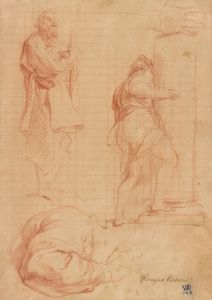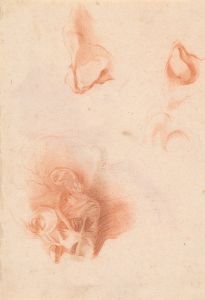
Venus Caressing Cupid
A hand-painted replica of Pompeo Batoni’s masterpiece Venus Caressing Cupid, meticulously crafted by professional artists to capture the true essence of the original. Each piece is created with museum-quality canvas and rare mineral pigments, carefully painted by experienced artists with delicate brushstrokes and rich, layered colors to perfectly recreate the texture of the original artwork. Unlike machine-printed reproductions, this hand-painted version brings the painting to life, infused with the artist’s emotions and skill in every stroke. Whether for personal collection or home decoration, it instantly elevates the artistic atmosphere of any space.
Pompeo Batoni's "Venus Caressing Cupid" is a notable example of 18th-century Italian painting, reflecting the artist's mastery in combining classical themes with the refined elegance characteristic of the Rococo period. Batoni, born in 1708 in Lucca, Italy, was a prominent painter known for his portraits and mythological subjects. His work often depicted figures from classical mythology, rendered with a sense of grace and beauty that appealed to the tastes of his contemporaries.
"Venus Caressing Cupid" showcases the Roman goddess of love, Venus, in a tender moment with her son, Cupid, the god of desire and affection. The painting captures a serene and intimate interaction between the two figures, emphasizing themes of maternal love and beauty. Batoni's skillful use of color and light enhances the softness and warmth of the scene, drawing the viewer's attention to the gentle expressions and delicate gestures of the figures.
The composition of the painting is carefully balanced, with Venus positioned prominently in the foreground. Her elegant pose and flowing drapery exemplify Batoni's ability to depict the human form with both anatomical accuracy and artistic grace. Cupid, depicted as a cherubic child, is nestled close to Venus, reinforcing the affectionate bond between mother and son. The background is typically subdued, allowing the figures to stand out and emphasizing the intimate nature of the scene.
Batoni's work was highly sought after by patrons across Europe, and his paintings were often commissioned by members of the aristocracy and the church. "Venus Caressing Cupid" reflects the artist's ability to cater to the tastes of his patrons, who were often interested in classical themes and the moral and allegorical messages they conveyed. The painting's subject matter would have resonated with contemporary audiences, who were familiar with the stories of Venus and Cupid from classical literature and art.
The painting is also a testament to Batoni's technical skill and his ability to blend elements of the Baroque and Rococo styles. While the composition and use of light show the influence of the Baroque, the painting's delicate color palette and emphasis on elegance and beauty are characteristic of the Rococo. This synthesis of styles is a hallmark of Batoni's work and contributes to his reputation as one of the leading painters of his time.
"Venus Caressing Cupid" is part of Batoni's broader oeuvre, which includes numerous portraits and mythological scenes. His work is celebrated for its clarity, precision, and the ability to convey complex emotions through simple yet powerful compositions. Today, Batoni's paintings are held in high regard and can be found in major museums and private collections around the world, where they continue to be appreciated for their artistic merit and historical significance.
In summary, "Venus Caressing Cupid" by Pompeo Batoni is a quintessential example of 18th-century Italian painting, reflecting the artist's skill in depicting classical themes with elegance and emotional depth. The painting remains an important work within Batoni's body of work and continues to be admired for its beauty and technical excellence.


















